“Cell service in Kandahar is apparently down, not just intermittent,” wrote Maloney, who chronicled the war as the Canadian Army’s official historian across more than a decade of fighting and 11 trips to Afghanistan.
Now he’s relying on sources inside the war-ravaged country to provide accounts and videos of the Taliban’s resurgence.
Platoon-sized Taliban checkpoints were using biometric devices and laptops to identify people who worked with the International Security Assistance Force and the international community. The checkpoints included pickup trucks, with running engines and equipped with recoilless rifles, and two pairs of motorcycles ready to pursue and cut off runaways.
Spin Boldak, on the Pakistan border 108 kilometres southeast of Kandahar, “was overrun in the past 24 hours,” he reported. The Afghan government later claimed it had retaken the town, where Canadian blood was shed more than a decade ago. The Taliban denied this claim.
Parts of Kandahar, birthplace of the Taliban movement, had fallen, although Maloney said the overall assault “has either petered out, or they have been told to stop” pending anticipated talks between the government and Taliban leaders.
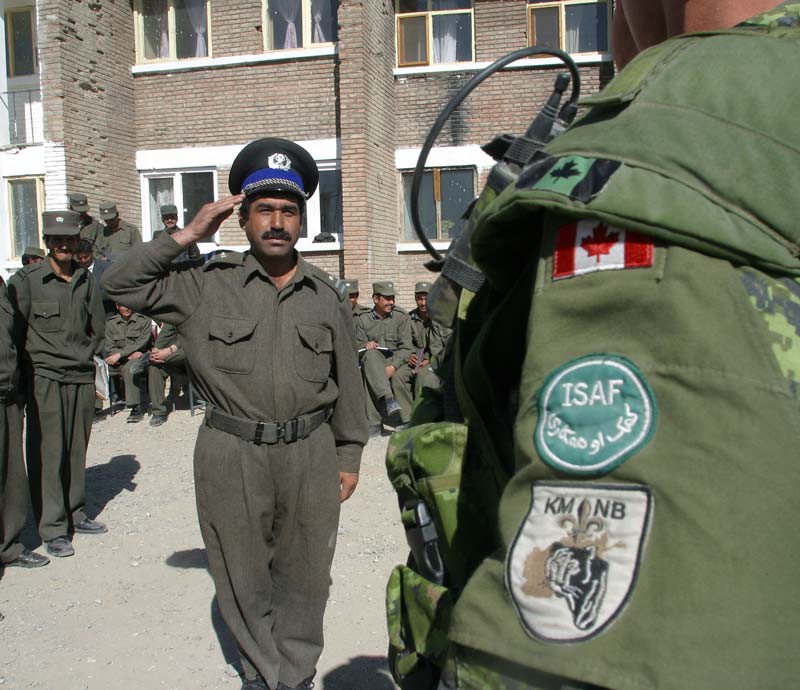
An Afghan graduate of the Canadian military’s police training program salutes a Canadian soldier in Kabul on Nov. 1, 2003. [Stephen J. Thorne/CP]
The news that Kandahar was teetering on the brink of collapse came less than a week after the Taliban claimed victory in Panjwai District, the centre of Canadian operations through much of their time patrolling and fighting out of the coalition airfield just south of the city and forward operating bases surrounding it.
Maloney’s reports and the news in general didn’t sit well with the soldiers who fought, bled and saw comrades die defending the area between 2006 and 2011.
“These updates are not doing anything for my mental health,” wrote veteran Neil Dancer. “Let’s stop.… I know it is really bumming me out, and I would imagine that it is triggering a lot of people.
“We get it, it is falling apart, but posting shit that will take people back to some bad times isn’t helping anyone.”
Indeed, the rapid developments and deterioration that followed the U.S. withdrawal in early July, though not unexpected by many, have caused waves of disappointment, frustration and bitterness among veterans of Canada’s 12-plus years at war in Afghanistan—so much so that the acting chief of the defence staff addressed the issue in an open letter on July 13.
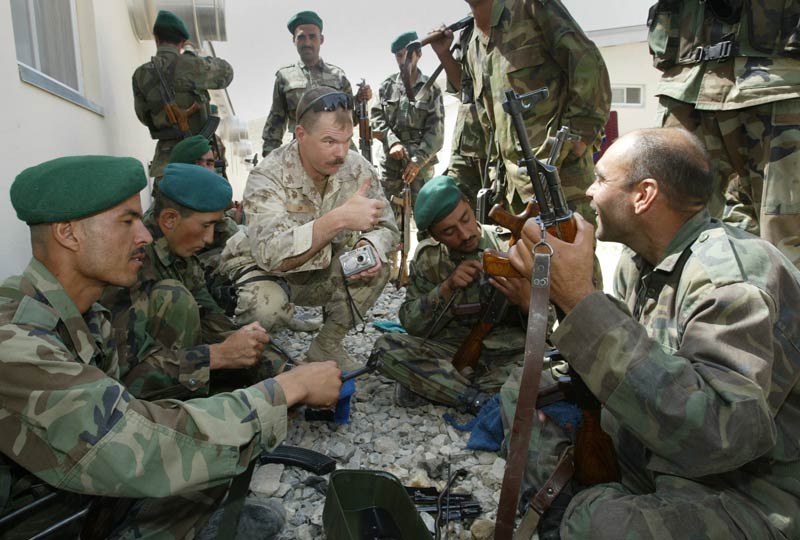
A Canadian trainer instructs Afghan National Army recruits in Kabul on Aug. 12, 2004. [Stephen J. Thorne/CP]
“Many of us have been asking, some for years, ‘was it worth it?’”
“Panjwai District, with its place names such as Masum Ghar, Nakhonay, Sperwan Ghar, and Mushan, [is] indelibly etched into the collective psyche of those who served there. The heat, the dust, the grape rows, and the poppy fields all provide a backdrop to what truly troubles us—our investment of effort, of sweat, and most of all of blood.
“Our Afghan experience has left none untouched, and many, including families, are scarred physically, mentally, and morally from it,” Eyre continued. “Many of us have been asking, some for years, ‘was it worth it?’ Answers will be deeply personal, and not all have reached a final conclusion other than ‘time will tell.’
“We can hold our heads high knowing that we did everything our government asked us to do. Our members served with valour and selflessness, and were there to make a difference. The solution was never going to be a military one, and what we gave the people and the government of Afghanistan was time.
“The decision with what to do with that time was theirs to make.”
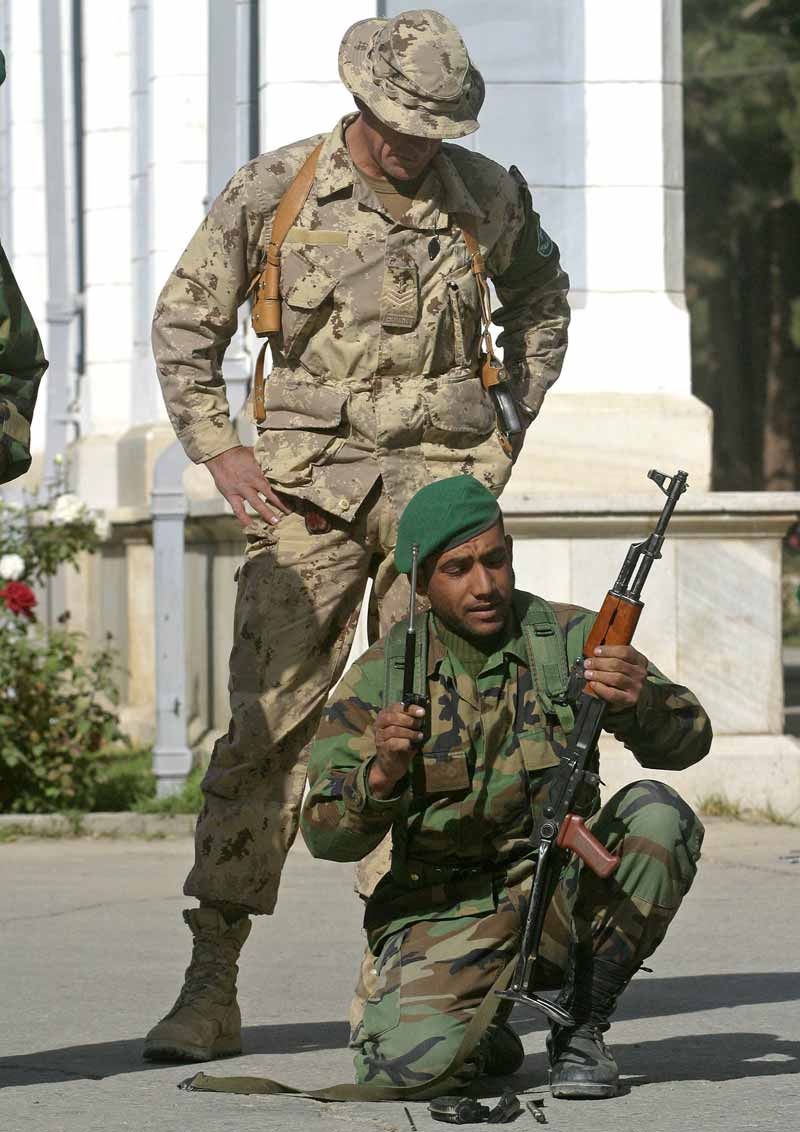
A Canadian instructor from the 3RCR Battle Group watches over an ANA recruit during training sessions at the presidential palace in Kabul on Oct. 29, 2003. [Stephen J. Thorne/CP]
“It feels like Srebrenica all over again,” said recently retired major Brian Hynes, who served two tours in Afghanistan, in 2002 and from 2004 to 2005. “It’s not a surprise.”
The besieged enclave in eastern Bosnia was the scene of a July 1995 massacre of more than 8,000 Bosniak Muslim men and boys by Bosnian Serb troops. The slaughter came after the United Nations had declared it a “safe area” under the protection of Canadian peacekeepers.
Afghanistan was “a lost cause from the get-go because we were never staying,” said Hynes, who was with the Royal Canadian Regiment when it became the first UN force get into Srebrenica in 1993. “That’s the message, really: If you’re going to go to war, you’re either there for the whole thing or you don’t go.
“A lot of people are going to have difficulties over this. We had people commit suicide after Srebrenica and it’s probably going to happen over this, as well. There are people barely holding on who will take this is as a gut punch.”
Alex Watson served three tours in the parched deserts, villages and mountains of Afghanistan, where he came to know and respect the long-suffering Afghan people for their courage, resilience, devotion and unfailing courtesy.
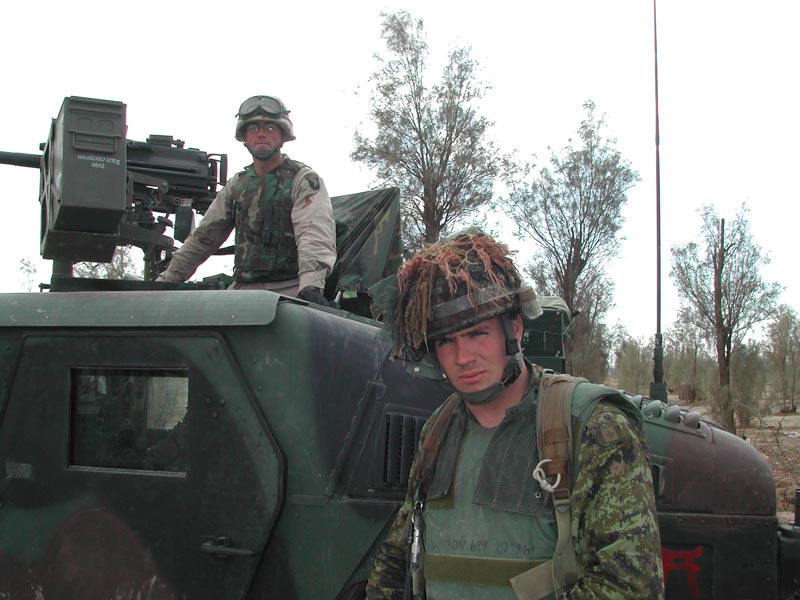
Then-captain Alex Watson alongside an American Humvee near Kandahar on Feb. 22, 2002. [Stephen J. Thorne/CP]
“I realize realistically I’m old and battered but I still feel that surge for combat in a righteous cause.”
“I have three feelings at once,” he said. “One is this emptiness, this ennui, about wasting a decade of my life.
“The second is a great fear and sadness for the people of Afghanistan, for whom I developed great affection.
“Third is that I’m fired up. I wish I were there, with my guys and my Afghan battalion, 1/1/205. My team didn’t lean on U.S. air power in 2009/2010, and we wouldn’t need to again. We could take them with small arms, just like last time.
“I realize realistically I’m old and battered but I still feel that surge for combat in a righteous cause.”

Accompanied by an interpreter, his face hidden to protect his identity, CAF veteran Alex Watson conducts CiMiC work near Kandahar on Feb. 22, 2002. [Stephen J. Thorne/CP]
“Regret that despite the gains, hard work and losses, the Afghan people were not able to hold on to the opportunity which we helped them to create,” he wrote in an email interview with Legion Magazine.
Now a reservist, he noted that Canadian successes against the Taliban in 2006 and 2007 “opened a window for reforms and development to take hold in the southern provinces.”
“For 14 years that opportunity held, even after Canada left in 2011,” said Bradley, referencing the end of Canada’s combat mission in the country three years before the full withdrawal.
He said tens of thousands of children had the opportunity to go to school and access health care. Women, too.

Lieutenant-Colonel Tom Bradley commands an operation near Kandahar in 2002. [Stephen J. Thorne/CP]
“Many Canadians seemed to think that a victory in Afghanistan would be ours to achieve, but the victory parade was never ours to have; it was the Afghans who would achieve that goal,” said Bradley. “The Afghans would determine the time and place and what it would look like.
“Unfortunately, despite years of advance warning that the patience of the electorate in the West was running thin and that the military and political support for Afghanistan would come to a close, it seems that the Afghan political class and their supporters in the West choose to avoid looking at what the consequence of this change would mean for both the Afghan people and their country.
“Instead they chose a standard political solution: pretend it’s not going to happen and carry on as if change only happens to others. Unfortunately the Afghans will now pay the price for that hubris.”
Shane Schreiber, a member of the Princess Patricia’s Canadian Light Infantry who retired a lieutenant-colonel after two tours in Afghanistan, said “we always knew—or ought to have known—that it was inevitably going to be up to the Afghans to decide their future.”
“We could give them time, space and resources, but they ultimately had to possess the will to use these,” he said. “It was a cause born of hope and good intentions, even if it looks hopeless now.”
Mark Campbell, a retired major who lost both legs to a remotely detonated bomb in Panjwai in June 2008, said he read news of the district’s fall “with a sense of resignation and finality.” He was mentoring ANA troops when he was targeted.

Retired major Mark Campbell lost his legs to a bomb blast in Panjwai District in June 2008. He said he read news of the district’s fall “with a sense of resignation and finality.” [Stephen J. Thorne]
What else could or should have been done? Sadly, said Campbell, probably nothing.
“NATO’s presence merely delayed the inevitable for 20 years in Kandahar Province. While it was a concerted effort on the part of contributing nations, 20 years was just the blink of an inadequate eye in Afghanistan’s long history of ill-fated foreign interventions.”
He predicted the country will likely end up a partitioned state with majority Pashtun rule in the southern third and majority Dari rule in the north—probably “the only viable way forward for the Afghan peoples.”
The distress many Canadian veterans feel at recent losses in areas they fought so long and hard to secure is compounded by the fact that many Afghans who helped them, including interpreters, remained stranded and facing potential torture and execution at the hands of the conquering Taliban.

With a Canadian mentor looking on, Afghan National Army soldiers disassemble their rifles at the presidential palace in Kabul on Oct. 29, 2003. [Stephen J. Thorne/CP]
“If we have a list, so do the Taliban.”
“On paper, this should have been sufficient,” he said. “Clearly, it is not.”
Innis said a group of retired senior ANA officers recently wrote a letter listing the names of Afghans who assisted Canadian forces and are now threatened in Kandahar and Kabul.
“If we have a list, so do the Taliban,” wrote Innis, “and it has become apparent over the past few weeks that this is not a kinder, gentler Taliban that we are dealing with.”

Afghan National Army soldiers coach a Canadian soldier through the disassembly of a Russian-made machine gun at the presidential palace in Kabul on Oct. 29, 2003. [Stephen J. Thorne/CP]
Innis said the Afghans who helped Canadians over the years now need Canada’s help. “This is a moral issue, and cuts to the heart of who we purport to be as a people and as a country.”
Immigration Minister Marco Mendicino said July 15 a plan was being finalized to bring Afghan interpreters and their families to Canada.
“We’ve already got teams on the ground who are assessing the security situation,” he told CBC Radio. “Our intention is to put this operation into action as quickly as possible.”
The issue is near and dear to many a Canadian soldier who worked closely with Afghans in the field, some of whom paid with their lives.
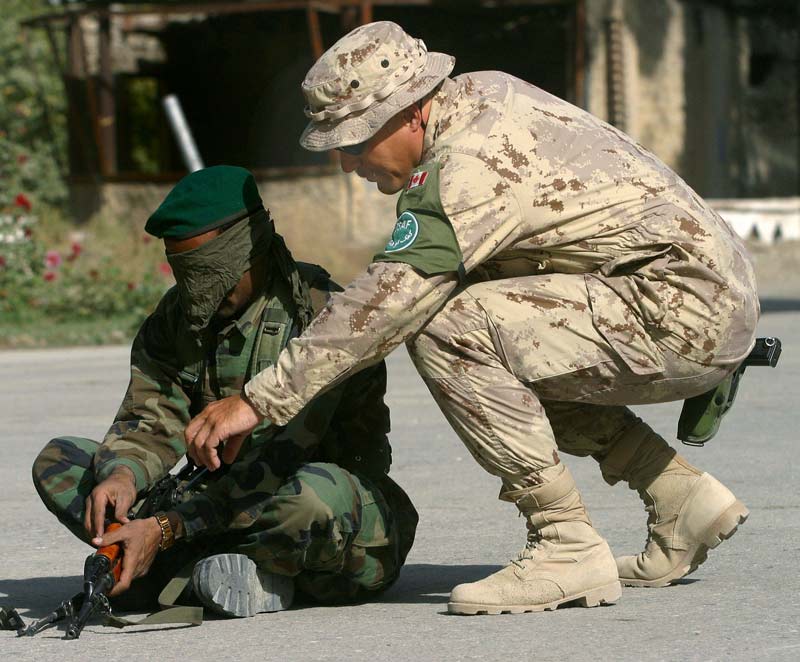
A Canadian soldier helps a blindfolded Afghan National Army soldier disassemble his rifle at the presidential palace in Kabul on Oct. 29, 2003. Twenty Canadian soldiers were seconded by the U.S.-led Operation Enduring Freedom to train Afghan soldiers. [Stephen J. Thorne/CP]
“My friend was able to give me a play-by-play over the next 48 hours until he disappeared from the communications medium we were using,” Maloney related in a 900-word account of his Afghanistan observations for Legion Magazine.
“‘What else is happening,’ I asked him. The Taliban are skinning captured police alive before killing them. ‘How do you know?’ We can hear them die.
“My comfortable life in Canada, one that I thought I had earned from years of going back and forth to Afghanistan risking my existence in pursuit of my task, came crashing to a halt.”
Maloney’s contacts sent him video of places he knew as intimately as his own neighbourhood back in Canada.

Soldiers attached to the 3rd Battalion, Royal 22nd Regiment Battle Group change a flat tire on a Bison armoured vehicle in hills southeast of Kabul on April 22, 2004. [Stephen J. Thorne/CP]
“Prey to the predators who want to kill him, merely for the fact he worked for Canada.”
An angry Maloney said his thoughts turned to his friend and the family he had started in 2011 “because he believed there was a future in Afghanistan where he could raise them as they should be, not converted into psychopathic killers, not turned into ideological robots, not affected by the horrors of war.
“And now that was gone. Gone. And now he is trapped. He is not a violent man. And now he is forced to fight for his and his family’s lives. Prey to the predators who want to kill him, merely for the fact he worked for Canada.”
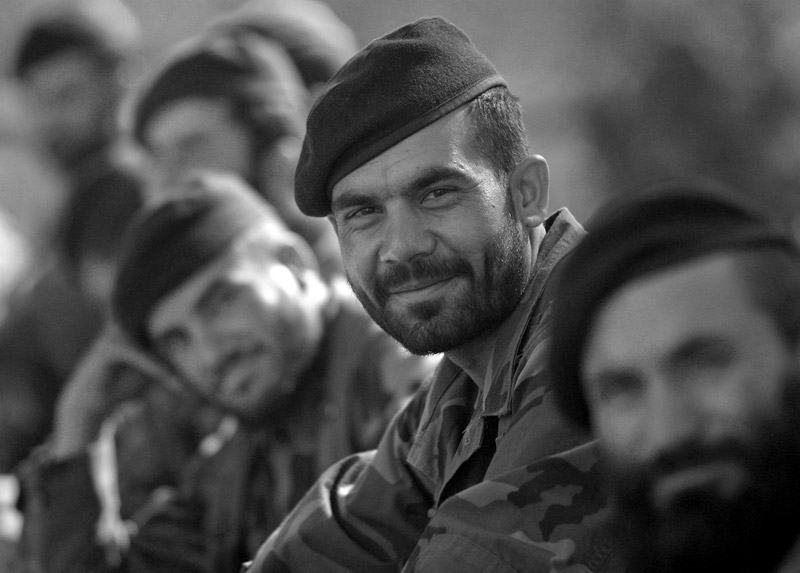
An ANA recruit. Afghan army forces have had limited success since U.S. forces left Afghanistan earlier this month. [Stephen J. Thorne/CP]
“At this moment in time, it is difficult to envision having similar sentiments for our war,” he wrote. “So where does that leave us? Should we hang our heads in bitterness and remorse; or should we continue to venerate the sacrifices of so many in our ranks and their families, to honour the noble commitment to service and making the world a better place, and endeavour to learn from our experiences, grow, and become better every day? While none of us can speak for them, I have to believe that our fallen would want us to pursue the latter.”
—
The DND has established an email address (afghanistan@forces.gc.ca) at which veterans and others can submit names and contact information for stranded Afghan interpreters. Mental health services are available to veterans through the VAC Assistance Service and to serving CAF and their families through the Member Assistance Program at 1-800-268-7708.
Advertisement






















